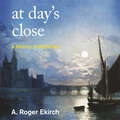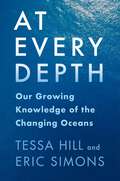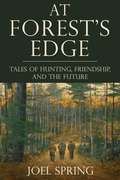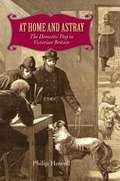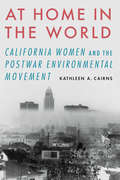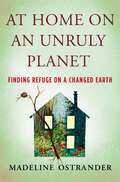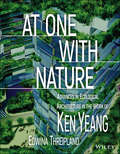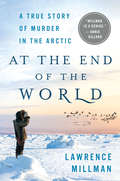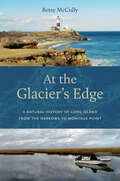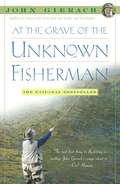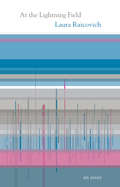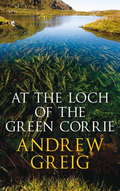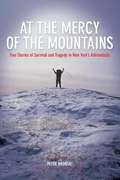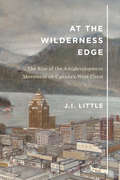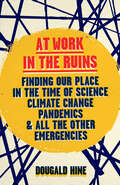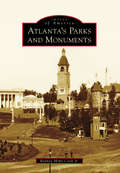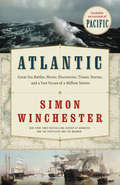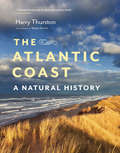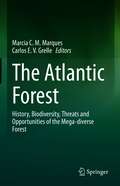- Table View
- List View
At Day's Close: A History of Nighttime
by Professor A. Roger EkirchA fascinating and colourful social history of the nighttime.'A wonderful revelation of a vanished age of darkness' SPECTATOR'Fascinating' SUNDAY TIMES'A splendid book ... great entertainment' Sir Patrick Moore'A triumph of social history. Almost every page contains something to surprise the reader ... one of the most enjoyable literary experiences of the year' MAIL ON SUNDAYFrom blanket fairs to night kings, curfews to crime, At Day's Close is an intriguing and captivating investigation into the night. Until now, this rich and complex universe in which we spend nearly half of our lives was a world long-lost to historians. Here, Ekirch explores how the night was lived in the past, through travel accounts, memoirs, letters, folklore, poems, court records and coroner's reports. More than this, it is a passionate argument in the case for less artificial light in an increasingly bright world.
At Every Depth: Our Growing Knowledge of the Changing Oceans
by Tessa Hill Eric SimonsThe world’s oceans are changing at a drastic pace. Beneath the waves and along the coasts, climate change and environmental degradation have spurred the most radical transformations in human history. In response, the people who know the ocean most intimately are taking action for the sake of our shared future. Community scientists track species in California tidepools. Researchers dive into the waters around Sydney to replant kelp forests. Scientists and First Nations communities collaborate to restore clam gardens in the Pacific Northwest.In At Every Depth, the oceanographer Tessa Hill and the science journalist Eric Simons profile these and other efforts to understand and protect marine environments, taking readers to habitats from shallow tidepools to the deep sea. They delve into the many human connections to the ocean—how people live with and make their living from the waters—journeying to places as far-flung as coral reefs, the Great Pacific Garbage Patch, and the Arctic and Antarctic poles. At Every Depth shares the stories of people from all walks of life, including scientists, coastal community members, Indigenous people, shellfish farmers, and fisheries workers. It brings together varied viewpoints, showing how scientists’ research and local and Indigenous knowledge can complement each other to inform a more sustainable future. Poignantly written and grounded in science, this book offers a narrative perspective on the changing oceans, letting us see how our relationships to the oceans are changing too.
At Forest's Edge: Tales of Hunting, Friendship, and The Future
by Joel SpringOutdoor literature lends itself well to reminiscence of the past; days gone by, hunts with old friends, and good dogs long gone. Joel Spring explored the past in depth with The Ghosts of Autumn (Skyhorse Publishing, 2016). In his latest work, At Forest&’s Edge, Spring turns his thoughts and insights to the future and the future of the sport of hunting. In essays span - ning a season afield, At Forest&’s Edge speaks to the upcoming generation of hunters as well as those of us who have a few more miles on our boots. The au - thor weaves humor, sadness, and a sense of hope seamlessly together in another engaging book. Inside you&’ll find deer and ducks, dogs and friends, adventure and reflection. Most importantly, you&’ll find hope for the future. Come take a walk with Joel Spring At Forest&’s Edge .
At Home and Astray
by Philip HowellAlthough the British consider themselves a nation of dog lovers, what we have come to know as the modern dog came into existence only after a profound, and relatively recent, transformation in that country's social attitudes and practices. In At Home and Astray, Philip Howell focuses on Victorian Britain, and especially London, to show how the dog's changing place in society was the subject of intense debate and depended on a fascinating combination of forces even to come about.Despite a relationship with humans going back thousands of years, the dog only became fully domesticated and installed at the heart of the middle-class home in the nineteenth century. Dog breeding and showing proliferated at that time, and dog ownership increased considerably. At the same time, the dog was increasingly policed out of public space, the "stray" becoming the unloved counterpart of the household "pet." Howell shows how this redefinition of the dog's place illuminates our understanding of modernity and the city. He also explores the fascinating process whereby the dog's changing role was proposed, challenged, and confronted--and in the end conditionally accepted. With a supporting cast that includes Charles Dickens, Elizabeth Barrett Browning, Thomas Carlyle, and Charles Darwin, and subjects of inquiry ranging from vivisection and the policing of rabies to pet cemeteries, dog shelters, and the practice of walking the dog, At Home and Astray is a contribution not only to the history of animals but also to our understanding of the Victorian era and its legacies.
At Home in the World: California Women and the Postwar Environmental Movement
by Kathleen A. CairnsFrom the beginning of California&’s statehood, adventurers, scientists, and writers reveled in its majestic landscape. Some were women, though few garnered attention or invitations to join the Sierra Club, the organization created in 1892 to preserve wilderness. Over the next sixty years the Sierra Club and other groups gained prestige and members—including an increasing number of women. But these organizations were not equipped to confront the massive growth of industry that overtook postwar California. This era needed a new approach, and it came from an unlikely source: white, middle-class housewives with no experience in politics. These women successfully battled smog, nuclear power plants, piles of garbage in the San Francisco Bay, and over-building in the Santa Monica Mountains. In At Home in the World Cairns shows how women were at the center of a broader and more inclusive environmental movement that looked beyond wilderness to focus on people&’s daily life. These women challenged the approach long promoted by establishment groups and laid the foundation for the modern environmental movement.
At Home on an Unruly Planet: Finding Refuge on a Changed Earth
by Madeline OstranderFrom rural Alaska to coastal Florida, a vivid account of Americans working to protect the places they call home in an era of climate crisisHow do we find a sense of home and rootedness in a time of unprecedented upheaval? What happens when the seasons and rhythms in which we have built our lives go off-kilter?Once a distant forecast, climate change is now reaching into the familiar, threatening our basic safety and forcing us to reexamine who we are and how we live. In At Home on an Unruly Planet, science journalist Madeline Ostrander reflects on this crisis not as an abstract scientific or political problem but as a palpable force that is now affecting all of us at home. She offers vivid accounts of people fighting to protect places they love from increasingly dangerous circumstances. A firefighter works to rebuild her town after catastrophic western wildfires. A Florida preservationist strives to protect one of North America's most historic cities from rising seas. An urban farmer struggles to transform a California city plagued by fossil fuel disasters. An Alaskan community heads for higher ground as its land erodes.Ostrander pairs deeply reported stories of hard-won optimism with lyrical essays on the strengths we need in an era of crisis. The book is required reading for anyone who wants to make a home in the twenty-first century.
At Home with Plants
by Ian Drummond Kara O'Reilly***A stylish addition to the current craze for indoor greenery, this is as much about how you use plants as an integral part of contemporary decor as how to keep them alive and well. - The Sunday TimesHouseplants are hot, and creative interior planting is becoming increasingly easy to achieve. The new wave of unusual and dramatic indoor plants is as much about décor and statement as greenery. Used aesthetically, as a focal point and sculptural element in interior design, indoor gardening is not just about possessing or growing a plant, but about using it as an accessory combined with other objects to create a particular style and mood. In this much-needed book, now reissued with a new cover and updated source directory, Ian and Kara show you how to transform your home with plants and tells you which plants will work best where and how to care for them. From strikingly geometric terrariums to pretty hanging baskets, practical herb pots and colourful window displays, this book is packed full of exciting and gorgeous ideas. Specially commissioned photography by Nick Pope throughout proves that bringing the outdoors in really is the best form of interior design.
At One with Nature: Advances in Ecological Architecture in the Work of Ken Yeang
by Ken Yeang Edwina Threipland"At One with Nature is an inspiring collection of the latest work of Ken Yeang that further advances sustainable architecture and design. This collection features recent projects as he explores how we can achieve harmony between the natural and our built environments to create a better planet by design. Each project features and highlights not only the systems and devices adopted, but also outlines the intentions and ecological considerations demonstrating best practices for how we can proceed moving forward. The book role models our living Earth and shows how we can behave as stewards of our planet."--Cassia Patel, Oceanic Global Foundation At One with Nature showcases Ken Yeang's latest ideas, built projects designs, research work and advances in the field of designing with nature, a topic that Yeang has pioneered and developed over many decades since receiving his doctorate in ecological design and planning from Cambridge University. His ideas and work are even more pertinent today with the current state of devastation of Earth's natural systems and a biogeochemical cycle that has been extensively and severely impacted by human society. The global environment today is in a state of crisis, but what can society do to address the issues? Yeang's recent projects are presented with instructive diagrams that provide a basis for action for architects, planners, designers, engineers, and anyone whose daily work impinges on the natural environment. Offered in a highly visual, annotated format, with instructive illustrations of Yeang's theoretical books on the topic, At One with Nature is an invaluable resource that students and academics interested in designing with nature will find both informative and relevant.
At the End of the World: A True Story of Murder in the Arctic
by Lawrence MillmanAt the End of the World is the remarkable story of a series of murders that occurred in an extremely remote corner of the Arctic in 1941. Those murders show that senseless violence in the name of religion is not only a contemporary phenomenon, and that a people as seemingly peaceful as the Inuit can become unpeaceful at the drop of a hat or, in this instance, a meteor shower. At the same time, the book is a warning cry against the destruction of what’s left of our culture’s humanity, along the destruction of the natural world. Has technology deprived us of our eyes? the author asks. Has it deprived the world of birds, beasts, and flowers? Lawrence Millman's At the End of the World is a brilliant and original book by one of the boldest writers of our era.
At the Glacier’s Edge: A Natural History of Long Island from the Narrows to Montauk Point
by Betsy McCullyVast salt marshes, ancient grasslands, lush forests, pristine beaches and dunes, and copious inland waters, all surrounded by a teeming sea. These are probably not the first things you imagine when you think of Long Island, but just beyond its highways and housing developments lies a stunning landscape full of diverse plant and animal life. Combining science writing, environmental history, and first-hand accounts from a longtime resident, At the Glacier’s Edge offers a unique narrative natural history of Long Island. Betsy McCully tells the story of how the island was formed at the end of the last ice age, how its habitats evolved, and how humans in the last few hundred years have radically altered and degraded its landscape. Yet as she personally recounts the habitat losses and species declines she has witnessed over the past few decades, she describes the vital efforts that environmental activists are making to restore and reclaim this land—from replanting salt marshes, to preserving remaining grasslands and forests, to cleaning up the waters. At the Glacier’s Edge provides an in-depth look at the flora, fauna and geology that make Long Island so special.
At the Grave of the Unknown Fisherman
by John GierachAt the Grave of the Unknown Fisherman is a journey through the year with America's finest fishing writer, John Gierach. The journey begins with an early spring expedition to Wyoming, where the dirt roads are still covered with a thin sheen of ice that quickly turns to mud underfoot. The conditions are so uninviting that everyone involved agrees they must be crazy to be fishing so early in the season. But, as Gierach observes, "nothing makes a fisherman happier than to have just proved that he must be crazy. " Gierach's fishing year ends with a winter fly-fishing trip in the Colorado Rockies, a time of year when, Gierach says, "it's still possible to have what seems like a whole river all to yourself. " Of course, the chances of catching any fish are small, a situation about which Gierach comments, "Anyone would go fishing thinking he'll catch something. It's when you go figuring you probably won't that you know you've crossed some kind of line. "In between, Gierach entertains us as always, mixing the one-liners about the fishing life with deeper insights into friendship, how we spend our time, and why nature still matters to us. At the Grave of the Unknown Fisherman contains Gierach's trademark blend of humor and acuity. Comparing trout and carp, he says, "If you wanted a fish that could sip white wine and discuss Italian poetry, you'd look for a trout. If you needed a ditch dug, you'd hire a carp. " Commenting on the value of a good map, he observes, "It seems like I've spent half my life trying to locate myself on maps, either just out of curiosity or to answer specific questions like Where the hell am I?' and 'How do I get out of here?' Gierach offers his opinions on the etiquette of sharing secret fishing spots, the ethics of lying to protect these spots, the secretive subculture of bamboo rods, and many other topics important to fishermen everywhere. Above all, however, Gierach understands that the real pleasure in fishing is greater than the sum of its accessories. He describes fish, mountain streams, birch thickets, and the joy of a beautiful day outdoors with a naturalist's eye and appreciation. And he understands fishing like the sage observer that he is: Fishing is one of the few ways I know of to let go of the past, forget about the future, and live in the moment. "Keenly observed and wryly recorded as always, John Gierach's latest book of fishing adventures and misadventures is sure to be enjoyed by anyone who fishes -- and everyone who wishes he fished more.
At the Heart of the Coral Triangle: Celebrating Biodiversity
by Alan J Powderham Sancia van der MeijThe Coral Triangle, straddling the confluence of the Indian and Pacific Oceans, harbours the greatest biodiversity of marine life on the planet. It is home to a wondrous variety, including 75% of the world's coral species and around 2500 species of fish. The biological and environmental diversity is driven by the volcanically active and complex geology of the so called 'Ring of Fire'. Habitats range from underwater slopes of volcanic black sand to extensive coral reefs in atolls and vast calderas. While clearly vulnerable to increasing global threats such as climate change, pollution and overfishing, the Coral Triangle currently features some the richest coral reefs in the world. With stunning photography supported by an engaging and accessible text, this book highlights and celebrates this biodiversity along with the underlying message that it needs our care and protection before it is too late.
At the Lightning Field
by Laura RaicovichWalter De Maria's "Lightning Field" is 400 stainless steel poles, positioned 220 feet apart, in the desert of central New Mexico. Over the course of several visits, it becomes, for Raicovich, a site for confounding and revealing perceptions of time, space, duration, and light; how changeable they are, while staying the same.
At the Loch of the Green Corrie
by Andrew GreigA homage to a remarkable poet and his world.'At The Loch of Green Corrie is more than merely elegant, more than a collection of albeit fascinating insights, laugh-out-loud observations and impressively broad erudition' - Sunday Herald'You could easily make a case that Andrew Greig has the greatest range of any living Scottish writer' - ScotsmanFor many years Andrew Greig saw the poet Norman MacCaig as a father figure. Months before his death, MacCaig's enigmatic final request to Greig was that he fish for him at the Loch of the Green Corrie; the location, even the real name of his destination was more mysterious still. His search took in days of outdoor living, meetings, and fishing with friends in the remote hill lochs of far North-West Scotland. It led, finally, to the waters of the Green Corrie, which would come to reflect Greig's own life, his thoughts on poetry, geology and land ownership in the Highlands and the ambiguous roles of whisky, love and male friendship. At the Loch of the Green Corrie is a richly atmospheric narrative, a celebration of losing and recovering oneself in a unique landscape, the consideration of a particular culture, and a homage to a remarkable poet and his world.
At the Loch of the Green Corrie
by Andrew GreigA homage to a remarkable poet and his world.'At The Loch of Green Corrie is more than merely elegant, more than a collection of albeit fascinating insights, laugh-out-loud observations and impressively broad erudition' - Sunday Herald'You could easily make a case that Andrew Greig has the greatest range of any living Scottish writer' - ScotsmanFor many years Andrew Greig saw the poet Norman MacCaig as a father figure. Months before his death, MacCaig's enigmatic final request to Greig was that he fish for him at the Loch of the Green Corrie; the location, even the real name of his destination was more mysterious still. His search took in days of outdoor living, meetings, and fishing with friends in the remote hill lochs of far North-West Scotland. It led, finally, to the waters of the Green Corrie, which would come to reflect Greig's own life, his thoughts on poetry, geology and land ownership in the Highlands and the ambiguous roles of whisky, love and male friendship. At the Loch of the Green Corrie is a richly atmospheric narrative, a celebration of losing and recovering oneself in a unique landscape, the consideration of a particular culture, and a homage to a remarkable poet and his world.
At the Mercy of The Mountains: True Stories of Survival and Tragedy In New York's Adirondacks
by Peter BronskiIn this compelling book, award-winning adventure writer and former Lower Adirondack Search and Rescue team member Peter Bronski chronicles true stories of survival and tragedy, from famous historical cases during the early 20th century, to modern tales of harrowing struggle in the mountains and wilderness. Extensively researched, these gripping tales pull together historical accounts, first-hand interviews, previously untold stories and expert analysis to retrace each misadventure
At the Root of It
by Robert NewellWhat grow underground and are strong enough to break through rock? The answer is roots. Roots are an amazing part of plants and trees. At the Root of It explains how roots work hard so plants and trees survive and grow.
At the Water's Edge: A Walk in the Wild
by John Lister-KayeFor the last thirty years John Lister-Kaye, one of Britain's best-known nature writers, has taken the same circular walk from his home deep in a Scottish glen up to a small hill loch. Each day brings a new observation or an unexpected encounter - a fragile spider's web, an osprey struggling to lift a trout from the water or a woodcock exquisitely camouflaged on her nest - and every day, on his return home, he records his thoughts in a journal.Drawing on this lifetime of close observation, John Lister-Kaye's new book encourages us to look again at the nature around us and to discover its wildness for ourselves. It also forges wonderful connections between the most unlikely subjects, from photosynthesis and the energy cycle to Norse mythology, to weasels and perfume and to the over-population of our planet.At the Water's Edge is a lyrical hymn to the wildlife of Britain, and a powerful warning to respect and protect it.
At the Wilderness Edge: The Rise of the Antidevelopment Movement on Canada's West Coast (McGill-Queen's Rural, Wildland, and Resource Studies #11)
by J. I. LittleVancouver prides itself on being a green city, and the west coast is known for its active environmental protest culture. But the roots of this mentality reach far beyond the founding of organizations such as Greenpeace. Small campaigns led by local community groups from the 1960s onward left a lasting impact on the region. At the Wilderness Edge examines five antidevelopment campaigns in and around Vancouver that reflected a dramatic decline in public support for large-scale commercial and industrial projects. J.I. Little describes the highly effective protests that were instrumental in preserving threatened green spaces on Coal Harbour, Hollyburn Ridge, Bowen Island, Gambier Island, and the Squamish estuary, keeping these important British Columbia landmarks from becoming a high-rise development project, a downhill ski resort, a suburban housing tract, an open-pit copper mine, and a major coal port, respectively. Through detailed analysis of development proposals and protests, government studies, and community responses, Little argues that it was not the usual suspects – 1960s radicalism and anti-establishment youth culture – that initiated and carried out these protests, but rather middle-aged, middle-class, politically engaged citizens, many of whom were women. An engaging study of grassroots politics in action, At the Wilderness Edge sheds new light on the rise of environmental consciousness, a pivotal era in the history of British Columbia, the Pacific Northwest, and Canada.
At Work in the Ruins: Finding Our Place in the Time of Science, Climate Change, Pandemics and All the Other Emergencies
by Dougald Hine'One of the most perceptive and thought-provoking books yet written about the multiple intersecting crises that are now upending our once-familiar world. . . Essential reading for these turbulent times.' Amitav Ghosh, author of The Great Derangement 'Hine’s brilliant book demands we stare into that abyss and rethink our securest certainties about what is actually going on in the climate crisis. It’s lucidly unsettling and yet in the end empowering. There is something we can do, and it starts with where we look, how we see and what we choose to change.’ Brian Eno, Musician Dougald Hine, author and social thinker, has spent most of his life talking to people about climate change. And then one afternoon in the second year of the pandemic, he found he had nothing left to say. Why would someone who cares so deeply about ecological destruction want to stop talking about climate change now? At Work in the Ruins explores that question. “Climate change asks us questions that climate science cannot answer,” Hine says. Questions like, how did we end up in this mess? Is it just a piece of bad luck with the atmospheric chemistry—or is it the result of a way of approaching the world that would always have brought us to such a pass? How we answer such questions has consequences. According to Hine, our answers shape our understanding and our thinking about what kind of problem we think we’re dealing with and, therefore, what kind of responses we go looking for. “But when science is turned into an object of belief and a source of overriding authority,” Hine continues, “it becomes hard even to talk about the questions that it cannot answer.” In eloquent, deeply researched prose, Hine demonstrates how our over-reliance on the single lens of science has blinded us to the nature of the crises around and ahead of us, leading to ‘solutions’ that can only make things worse. At Work in the Ruins is his reckoning with the strange years we have been living through and our long history of asking too much of science. It’s also about how we find our bearings and what kind of tasks are worth giving our lives to, given all we know or have good grounds to fear about the trouble the world is in. For anyone who has found themselves needing to make sense of the COVID time and how we talk about it, At Work in the Ruins offers guidance by standing firmly forward and facing the depth of the trouble we are in. Hine, ultimately, helps us find the work that is worth doing, even in the ruins. 'A book of rare originality and depth—profound, far-reaching, mind-altering stuff.' Helen Jukes, author of A Honeybee Heart has Five Openings
Atlanta's Parks and Monuments
by Rodney Mims Cook Jr.Since the city's beginnings after the War of 1812, Atlanta has had a tradition of building with a regard for becoming a world-class metropolis. Before being burned by Union general William T. Sherman in 1864, the city's appearance was described by noted European architect and urban planner Leon Krier as "looking like London in the 18th century." Atlanta was surrounded by estates and plantations, and many of the plantation builders were influenced by Greek and Roman architecture. The argument of slavery to the contrary, builders saw Greek temples as symbols of democracy and, as a result, embraced Greek and Roman revival architecture as the dominant national style. Great monuments followed in this tradition to the letter in the capital of the South.
Atlantic
by Simon WinchesterBlending history and anecdote, geography and reminiscence, science and exposition, the New York Times bestselling author of Krakatoa tells the breathtaking saga of the magnificent Atlantic Ocean, setting it against the backdrop of mankind's intellectual evolution Until a thousand years ago, no humans ventured into the Atlantic or imagined traversing its vast infinity. But once the first daring mariners successfully navigated to far shores-whether it was the Vikings, the Irish, the Chinese, Christopher Columbus in the north, or the Portuguese and the Spanish in the south-the Atlantic evolved in the world's growing consciousness of itself as an enclosed body of water bounded by the Americas to the West, and by Europe and Africa to the East. Atlantic is a biography of this immense space, of a sea which has defined and determined so much about the lives of the millions who live beside or near its tens of thousands of miles of coast. The Atlantic has been central to the ambitions of explorers, scientists and warriors, and it continues to affect our character, attitudes, and dreams. Poets to potentates, seers to sailors, fishermen to foresters-all have a relationship with this great body of blue-green sea and regard her as friend or foe, adversary or ally, depending on circumstance or fortune. Simon Winchester chronicles that relationship, making the Atlantic come vividly alive. Spanning from the earth's geological origins to the age of exploration, World War II battles to modern pollution, his narrative is epic and awe-inspiring.
The Atlantic Coast
by Wayne Barrett Harry ThurstonThe North Atlantic coast of North America-commonly known as the Atlantic Coast-extends from Newfoundland and Labrador through the Maritime Provinces and the Northeastern United States south to Cape Hatteras. This North Atlantic region belongs to the sea. The maritime influence on climate, flora, and fauna is dominant - even far inland. Both on land and at sea, this region is where north meets south, where the great northern boreal forests intermingle with the southern coniferous-hardwood forests, and where the icy Labrador Current and the tropical Gulf Stream vie for supremacy and eventually mix. The Atlantic Coast draws upon the best and most up-to-date science on the ecology of the region as well as the author's lifetime experience as a resident, biologist, and naturalist. The book explores the geological origins of the region, the two major forest realms, and the main freshwater and marine ecosystems, and describes the flora and fauna that characterize each habitat. It ends with a look at what has been lost and how the remaining natural heritage of the region might be conserved for the future.
The Atlantic Forest: History, Biodiversity, Threats and Opportunities of the Mega-diverse Forest
by Marcia C. M. Marques Carlos E. V. GrelleThe Atlantic Forest is one of the 36 hotspots for biodiversity conservation worldwide. It is a unique, large biome (more than 3000 km in latitude; 2500 in longitude), marked by high biodiversity, high degree of endemic species and, at the same time, extremely threatened. Approximately 70% of the Brazilian population lives in the area of this biome, which makes the conflict between biodiversity conservation and the sustainability of the human population a relevant issue. This book aims to cover: 1) the historical characterization and geographic variation of the biome; 2) the distribution of the diversity of some relevant taxa; 3) the main threats to biodiversity, and 4) possible opportunities to ensure the biodiversity conservation, and the economic and social sustainability. Also, it is hoped that this book can be useful for those involved in the development of public policies aimed at the conservation of this important global biome.
Atlantic High: A Celebration
by William F. Buckley Jr.William F. Buckley Jr.'s account of his voyage across the Atlantic Ocean in the sailboat Sealestial, Atlantic High is a work that everywhere evidences Buckley's love for sailing and good companionship. Infused with his inimitable wit and supported by a rich fund of anecdotes and observations, Atlantic High is truly a one-of-a-kind work.
